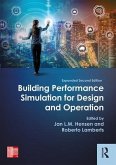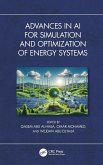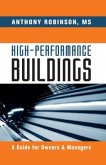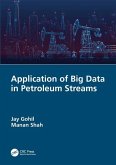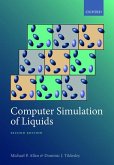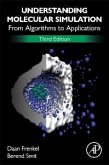Vishal Garg, Jyotirmay Mathur, Aviruch Bhatia
Building Energy Simulation
A Workbook Using DesignBuilder(TM)
Vishal Garg, Jyotirmay Mathur, Aviruch Bhatia
Building Energy Simulation
A Workbook Using DesignBuilder(TM)
- Broschiertes Buch
- Merkliste
- Auf die Merkliste
- Bewerten Bewerten
- Teilen
- Produkt teilen
- Produkterinnerung
- Produkterinnerung
The 2nd edition of Building Energy Simulation includes study of various components and systems of a building and their effect on energy consumption, with the help of DesignBuilderTM supported by examples and exercises. It explains simulation input parameters and how to do analysis of the simulation output explaining building physics concepts.
Andere Kunden interessierten sich auch für
![Building Performance Simulation for Design and Operation Building Performance Simulation for Design and Operation]() Building Performance Simulation for Design and Operation173,99 €
Building Performance Simulation for Design and Operation173,99 €![Advances in AI for Simulation and Optimization of Energy Systems Advances in AI for Simulation and Optimization of Energy Systems]() Advances in AI for Simulation and Optimization of Energy Systems108,99 €
Advances in AI for Simulation and Optimization of Energy Systems108,99 €![High-Performance Buildings High-Performance Buildings]() M.S. RobinsonHigh-Performance Buildings147,99 €
M.S. RobinsonHigh-Performance Buildings147,99 €![Application of Big Data in Petroleum Streams Application of Big Data in Petroleum Streams]() Jay Gohil (India Pandit Deendayal Petroleum University)Application of Big Data in Petroleum Streams68,99 €
Jay Gohil (India Pandit Deendayal Petroleum University)Application of Big Data in Petroleum Streams68,99 €![Application of Big Data in Petroleum Streams Application of Big Data in Petroleum Streams]() Jay Gohil (India Pandit Deendayal Petroleum University)Application of Big Data in Petroleum Streams123,99 €
Jay Gohil (India Pandit Deendayal Petroleum University)Application of Big Data in Petroleum Streams123,99 €![Computer Simulation of Liquids Computer Simulation of Liquids]() Michael P. Allen (Emeritus Professor and Emeritus Visiting FellowComputer Simulation of Liquids92,99 €
Michael P. Allen (Emeritus Professor and Emeritus Visiting FellowComputer Simulation of Liquids92,99 €![Understanding Molecular Simulation Understanding Molecular Simulation]() Daan Frenkel (FOM Institute for Atomic and The N Molecular PhysicsUnderstanding Molecular Simulation118,99 €
Daan Frenkel (FOM Institute for Atomic and The N Molecular PhysicsUnderstanding Molecular Simulation118,99 €-
-
-
The 2nd edition of Building Energy Simulation includes study of various components and systems of a building and their effect on energy consumption, with the help of DesignBuilderTM supported by examples and exercises. It explains simulation input parameters and how to do analysis of the simulation output explaining building physics concepts.
Produktdetails
- Produktdetails
- Verlag: Taylor & Francis Ltd
- 2 ed
- Seitenzahl: 724
- Erscheinungstermin: 7. September 2020
- Englisch
- Abmessung: 179mm x 254mm x 54mm
- Gewicht: 1418g
- ISBN-13: 9780367374686
- ISBN-10: 0367374684
- Artikelnr.: 59990723
- Herstellerkennzeichnung
- Libri GmbH
- Europaallee 1
- 36244 Bad Hersfeld
- gpsr@libri.de
- Verlag: Taylor & Francis Ltd
- 2 ed
- Seitenzahl: 724
- Erscheinungstermin: 7. September 2020
- Englisch
- Abmessung: 179mm x 254mm x 54mm
- Gewicht: 1418g
- ISBN-13: 9780367374686
- ISBN-10: 0367374684
- Artikelnr.: 59990723
- Herstellerkennzeichnung
- Libri GmbH
- Europaallee 1
- 36244 Bad Hersfeld
- gpsr@libri.de
Vishal Garg is professor and head of the Center for IT in Building Science, International Institute of Information Technology (IIIT), Hyderabad, India. His current research interests are in the areas of energy simulation, smart homes and cool roofs. He teaches building automation and controls, energy simulation, and illumination engineering. He has conducted several national and international workshops on intelligent buildings, green buildings and energy simulation. He holds a BTech (Hons.) degree in civil engineering from MBM Engineering College, Jodhpur, India and a PhD from the Indian Institute of Technology, Delhi, India. Dr. Garg is actively involved in the green building movement, and in developing eTools and educational platforms for advancing energy efficiency in buildings and energy efficiency building code and its implementation. He was the founding president of the Indian chapter of the International Building Performance Simulation Association (IBPSA) and chaired the organizing committee of the International Conference for Building Simulation 2015 and the International Conference on Countermeasures to Urban Heat Islands (IC2UHI) 2019. He is a fellow of IBPSA and received the inaugural Arthur H. Rosenfeld Urban Cooling Achievement Award in 2018. Jyotirmay Mathur is professor of mechanical engineering and the founding head of the Centre for Energy and Environment at Malaviya National Institute of Technology, Jaipur, India. He has done postgraduate work in energy studies at the Indian Institute of Technology, Delhi, India, and has received a doctorate in energy systems from the University of Essen, Germany. Dr. Mathur has published 80 research papers in refereed international journals and has presented more than 150 papers and talks at international seminars and conferences, besides writing five books. Dr. Mathur works in the field of energy modelling, codes and standards, energy conservation in buildings, passive cooling, adaptive thermal comfort and building integrated photovoltaic systems. Aviruch Bhatia is assistant professor at the TERI School of Advanced Studies, New Delhi, India. He holds a PhD from the International Institute of Information Technology, Hyderabad, India, an MTech degree in energy engineering from the Malaviya National Institute of Technology, Jaipur, India, and MSc and MPhil degrees in physics from the University of Rajasthan, Jaipur, India. His areas of interest include building physics, calibrated energy simulation and fault detection and diagnostics in heating, ventilation and air conditioning systems. He has also worked for three years as an assistant manager at Sustainability Group of Spectral Consultant, Pvt. Ltd. (an AECOM company).
1. Getting Started with Energy Simulation. 2. Geometry of Buildings. 3.
Material and Construction. 4. Openings and Shading. 5. Lighting and
Controls. 6. Heating and Cooling Design. 7. Unitary HVAC systems. 8.
Heating Ventilation and Air Conditioning - Central Water Side. 9. Heating
Ventilation and Air Conditioning - Central Air Side. 10. Natural
Ventilation. 11. Simulation Parameters. 12. Renewable Energy System. 13.
Costing, Sensitivity and Uncertainty Analysis. 14. Building Energy Code
Compliance.
Material and Construction. 4. Openings and Shading. 5. Lighting and
Controls. 6. Heating and Cooling Design. 7. Unitary HVAC systems. 8.
Heating Ventilation and Air Conditioning - Central Water Side. 9. Heating
Ventilation and Air Conditioning - Central Air Side. 10. Natural
Ventilation. 11. Simulation Parameters. 12. Renewable Energy System. 13.
Costing, Sensitivity and Uncertainty Analysis. 14. Building Energy Code
Compliance.
1. Getting Started with Energy Simulation. 2. Geometry of Buildings. 3.
Material and Construction. 4. Openings and Shading. 5. Lighting and
Controls. 6. Heating and Cooling Design. 7. Unitary HVAC systems. 8.
Heating Ventilation and Air Conditioning - Central Water Side. 9. Heating
Ventilation and Air Conditioning - Central Air Side. 10. Natural
Ventilation. 11. Simulation Parameters. 12. Renewable Energy System. 13.
Costing, Sensitivity and Uncertainty Analysis. 14. Building Energy Code
Compliance.
Material and Construction. 4. Openings and Shading. 5. Lighting and
Controls. 6. Heating and Cooling Design. 7. Unitary HVAC systems. 8.
Heating Ventilation and Air Conditioning - Central Water Side. 9. Heating
Ventilation and Air Conditioning - Central Air Side. 10. Natural
Ventilation. 11. Simulation Parameters. 12. Renewable Energy System. 13.
Costing, Sensitivity and Uncertainty Analysis. 14. Building Energy Code
Compliance.


